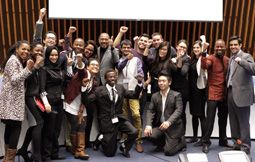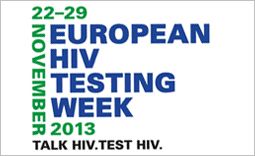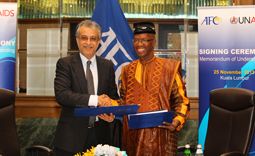
Feature Story
UNAIDS in action 2006
22 décembre 2006
22 décembre 2006 22 décembre 20062006 has been an important year in the AIDS response. The number of people living with HIV rose to almost 40 million, the highest number ever, however declines in infection rates were observed in some countries, as well as positive trends in young people's sexual behaviours. HIV Prevention efforts were shown to be working in a number of countries, highlighting the need to urgently scale up, expand and adapt prevention programmes to address the different drivers of the epidemics.
Political commitment to the AIDS response was at its highest level to date which was reflected at the 2006 High Level Meeting on AIDS at the UN in New York. Heads of State and Government and representatives of States and Governments came together to debate key AIDS issues and unanimously adopted a political declaration on AIDS. During the meeting countries also pledged to set ambitious national targets for universal access to HIV prevention, treatment care and support. By the end of 2006 many countries had already set their targets.
In 2006, key developments were brought to light in the field of scientific research—including increased emphasis on microbicide development and findings relating to male circumcision. More people than ever before were receiving antiretroviral treatment and funds pledged for the AIDS response reached their highest levels to date.
2006 also marked 25 years since the virus was first discovered over which time some 25 million people have died of AIDS.
2006 was also the 10 th anniversary of the Joint United Nations Programme on HIV/AIDS (UNAIDS) during which time UNAIDS has spearheaded many innovative initiatives that have accelerated the AIDS response worldwide.
In 2006 , UNAIDS enlisted the help of a number of new special representatives to strengthen communication of key messages and reach out a broader audience than ever before.
Below are some of the highlights and key events which took place during 2006.
| JANUARY | |
| AIDS: everybody’s business | |
 |
Business leaders met in Davos in January for the 2006 World Economic Forum, many turned their attention to the issue of the increasing impact of AIDS in the workplace. |
| The road towards universal access | |
|
As requested by the General Assembly in resolution 60/224 adopted in December 2005, UNAIDS secretariat and co-sponsors started facilitating inclusive, country-driven processes to identify practical actions for scaling up AIDS services towards universal access. Thousands of people from all walks of life were mobilized to seize this extraordinary opportunity. Between January and March, more than 100 low- and middle-income countries held broad public debates about what needs to be done to turn back the epidemic. Seven regional consultations were held. The UNAIDS secretariat also convened a multipartner Global Steering Committee. |
|
| FEBRUARY | |
| The need to invest in HIV prevention | |
|
A study, published in Sciencexpress in February, indicated that increased spending on HIV prevention would not only prevent more than half the new infections that would occur from 2005 to 2015, but would actually produce a net financial saving as future costs for treatment and care are averted. |
|
| World not doing nearly enough to protect children affected by AIDS | |
|
In February, the Global Partners Forum, hosted by UNICEF and the UK Department for International Development, brought together 90 international organizations, NGOs and governments in a special effort to ramp up practical responses for children affected by the AIDS epidemic. |
|
| Innovative AIDS funding takes off | |
|
An international conference on “Solidarity and Globalization: innovative financing for development and against pandemics”, held in Paris in February, brought together representatives from more than one hundred countries, 18 international organizations and 60 NGOs to discuss the implementation of innovative financing for development. |
|
| AIDS mission to Rwanda to discuss next steps in AIDS response | |
|
In February, leading representatives from Luxemburg, the United Kingdom’s Department for International Development, UNICEF and the Joint United Nations Programme on HIV/AIDS visited Rwanda for a two-day, high-level mission to gain a joint perspective on the progress of the national AIDS response and the ongoing challenges it faces. |
|
| MARCH | |
| Economic security for women key to HIV prevention | |
| |
A new paper published in March by the UNAIDS-led Global Coalition on Women and AIDS showed that when women have an income and a safe place to live, they are much better able to negotiate abstinence, fidelity, and safer sex. Economic security, the paper stressed, is a major factor in enabling women to protect themselves from HIV. |
| Positive partnerships break down AIDS-discrimination in Thailand | |
| |
Heralded by UNAIDS as an example of ‘best practice’, a project that offers small loans to enable people living with HIV set up businesses is helping break down stigma and discrimination in Thailand. |
| Global access to HIV therapy tripled in past two years, but significant challenges remain | |
|
A new report by the World Health Organization (WHO) and the Joint United Nations Programme on HIV/AIDS (UNAIDS) shows that the number of people on HIV antiretroviral treatment (ART) in low- and middle-income countries more than tripled to 1.3 million in December 2005 from 400 000 in December 2003. Charting the final progress of the "3 by 5" strategy to expand access to HIV therapy in the developing world, the report also says that the lessons learned in the last two years provide a foundation for global efforts now underway to provide universal access to HIV treatment by 2010. |
|
| APRIL | |
| Declaration of Commitment on HIV/AIDS: five years later – Report of the Secretary General | |
|
The report of the Secretary-General provided an update on progress in the global AIDS response since the 2001 special session, identified critical challenges and made urgent recommendations to strengthen efforts at the global, regional and country levels. |
|
| UNAIDS assessment report on the road towards universal access released | |
|
Reaching the Millennium Development Goal on HIV and AIDS – to halt and reverse the spread of the epidemic by 2015 – requires far greater access to HIV prevention services and AIDS treatment, care and support than is currently available. The assessment report includes an analysis of common obstacles and recommendations for overcoming them by integrating HIV prevention, treatment, care and support with broader health and social services. |
|
| President Putin calls for urgent measures to stem the HIV epidemic in Russia | |
| |
President Vladimir Putin gathered the Presidium of the State Council to discuss the HIV epidemic in Russia. In a groundbreaking move, the State Council examined all aspects of the growing epidemic in the country and agreed on a set of measures that will strengthen Russia’s response to the epidemic in an unprecedented manner. |
| MAY | |
| Launch of the 2006 Report on the global AIDS epidemic | |
| |
On the eve of the 2006 High Level Meeting on AIDS in New York UNAIDS launched the 2006 Report on the global AIDS epidemic, featuring the latest AIDS estimates and new trends. The report, a special edition marking UNAIDS' 10th anniversary, contained the most in-depth data from countries to date, based on progress reports from 126 countries. |
| Eastern Europe and Central Asia are facing the challenge | |
| |
Under the theme “facing the challenge” the first Eastern European and Central Asian AIDS conference welcomed around 1500 participants in Moscow from 15 to 17 May. The conference provided an important forum for political leaders, scientists and researchers, people living with HIV and representatives from civil society to take stock of the AIDS response in the region. |
| JUNE | |
| Agenda for action on women and AIDS | |
|
On 1 June, the UNAIDS-led Global Coalition on Women and AIDS launched a new Agenda for Action - calling for massively scaled-up funding for AIDS programmes for women and girls; the effective enforcement of laws that affirm and protect women's rights, and greater involvement in women (particularly positive women) in forums where AIDS policies and programmes are decided. |
|
| 2006 High Level Meeting on AIDS | |
| |
High-level representatives of over 140 UN Member States, including nearly a dozen Heads of State and Government, met in June to review progress towards achieving the agreed goals of the Declaration of Commitment on HIV/AIDS adopted at the UN General Assembly Special Session on AIDS in 2001. The 2006 High Level Meeting on AIDS concluded with a renewed political commitment and agreement on future action to reverse the global AIDS epidemic and reduce its impact. |
| Gauging progress in Malawi | |
| |
Dr. Peter Piot, Executive Director of UNAIDS and Sir Suma Chakrabarti, Permanent Secretary, United Kingdom Department for International Development visited Malawi to review progress made in the country’s AIDS response. Malawi’s political leadership and commitment in accelerating universal access to HIV prevention, treatment care and support was one of the focal points of the visit. |
| JULY | |
| Investigating the impact of AIDS in Asia and the Pacific | |
|
A new body to study the spread and impact of HIV and AIDS in the Asia Pacific region was launched in July in New Delhi. The Independent Commission on AIDS in Asia and the Pacific consists of 10 leading economists, scientists, civil society representatives and policy-makers from across the region. |
|
| UN Secretary-General meets pharmaceutical companies to discuss access to treatment | |
| |
The UN Secretary-General met with CEOs from the world’s leading pharmaceutical companies and UN officials in New York to explore ways to expand access to HIV treatment and care in low-and-middle income countries. The meeting was the first of its kind to include both research and development - or ‘brand name’ – pharmaceutical companies, generic development companies and UN bodies. |
| Health leaders welcome infectious disease focus at G8 | |
| |
In advance of the G8 summit, the leaders of the four key health policy and financing organizations - the World Health Organization (WHO),UNAIDS, the Global Fund to Fight AIDS, Tuberculosis and Malaria, and the GAVI Alliance - jointly welcomed the focus on infectious diseases and urged the G8 leaders to continue their commitments to improving the health and lives of people in the world's poorest countries. |
| AUGUST | |
| UNAIDS Executive Director meets with Indian Prime Minister | |
|
Dr Peter Piot met with Indian Prime Minister Dr Manmohan Singh in August. The Prime Minister's leadership has put the AIDS response on the national political agenda. As the Chairperson of the National Council on AIDS, Dr. Singh has developed a multi-ministerial task force comprising of 31 ministries and seven state governments for a coordinated multi-sectoral response to the HIV epidemic in India. |
|
| XVI International AIDS Conference, Toronto, Canada | |
| |
Over the week 13-18 August, 24,000 people participated in the XVI International AIDS Conference, including high-profile guests such as former US President Bill Clinton, Bill and Melinda Gates, leaders from governments, the science sector, civil society, people living with HIV, youth and women’s groups, United Nations officials, business, the private sector and the entertainment sector. UNAIDS took part in a wide variety of satellites, sessions and events over the week. |
| Uniting for HIV Prevention | |
| |
UNAIDS, civil society, treatment activists, private sector and governments call for ‘out of the ordinary partnerships’ to intensify HIV prevention efforts. |
| SEPTEMBER | |
| Responding to AIDS in China | |
| |
UNAIDS Executive Director Peter Piot visited China in September to encourage continued leadership and commitment and to mobilize a multi-sectoral response to AIDS. |
| Emerging epidemics in Eastern Europe on the agenda | |
|
In September, UNAIDS Executive Director Dr Peter Piot visited Berlin to discuss ways of strengthening collaboration between UNAIDS and Germany and to promote continued commitment to the AIDS response. Dr Piot met with Government Ministers, parliamentary representatives, the National AIDS Council and NGO representatives. |
|
| OCTOBER | |
| Setting ambitious national targets: The next step on the road towards universal access | |
| |
In October, UNAIDS published new, operational guidelines to support countries’ efforts to set ambitious national targets that reflect international commitment to scale up significantly towards the goal of universal access to comprehensive prevention programmes, treatment, care and support by 2010. |
| NOVEMBER | |
| Asia Pacific: Call for action on AIDS | |
| |
Asia and Pacific countries with low HIV prevalence rates called for action to increase targeted HIV prevention efforts and funding for AIDS, at the ‘Low to Zero’ Asia Pacific regional conference on universal access to HIV prevention, treatment, care and support in low prevalence countries, that took place in Mongolia in October. |
| UN Secretary General visits UNAIDS, Geneva | |
| |
In one of his final public appearances as UN Secretary General, Kofi Annan visited UNAIDS in Geneva on Monday 20 November. The Secretary General urged the international community to continue to “fight to bring the global AIDS epidemic under control.” |
| UNAIDS/WHO launch 2006 AIDS epidemic update | |
| |
UNAIDS launched the new joint UNAIDS/WHO report, AIDS Epidemic Update 2006, featuring updated global and regional AIDS estimates and new trends in the epidemic’s evolution on 21 November 2006. |
| DECEMBER | |
| World AIDS Day 2006 | |
| |
With nearly 40 million people living with HIV in 2006, this year's World AIDS Day theme of 'accountability' was a poignant reminder that we all have a role to play in the AIDS response and we are all accountable for the promises we have made. On 1 December events took place around the globe to commemorate this special day of remembrance and hope. |
| Setting targets for universal access to HIV prevention, treatment, care and support | |
| |
Throughout 2006, countries across the world have been taking positive steps to accelerate their national response in order to halt and reverse the AIDS epidemic by 2015. By the end of 2006, a number of countries had already set ambitious national targets, while others, building the process into their existing national strategic planning cycle, are due to continue this process throughout the coming months. |
| Statement on trial findings regarding male circumcision and HIV | |
|
UNAIDS and its Cosponsors, WHO, UNFPA, UNICEF and the World Bank, release a joint statement regarding the announcement by the US National Institutes of Health that two trials assessing the impact of male circumcision on HIV risk are being stopped on the recommendation of the NIH Data Safety and Monitoring Board (DSMB). |
|



